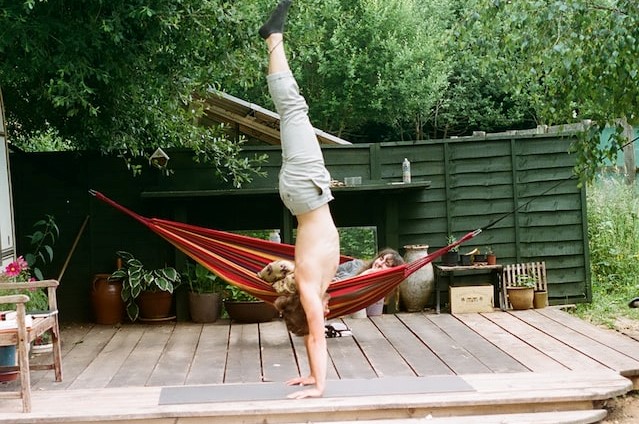Holding a handstand is a challenging and impressive calisthenics move that requires not only physical strength and coordination but also mental focus and determination. It’s a great exercise for building upper body and core strength, increasing body awareness, and improving balance. If you’re a calisthenics enthusiast, you’ve probably tried to hold a handstand and found it challenging to stay in the position for more than a few seconds. In this article, we’ll share tips and techniques on how to hold a handstand longer, including proper form and alignment, strength-building exercises, balance drills, and mindfulness techniques. We’ll also cover different handstand variations and progressions to help you take your practice to the next level. Whether you’re a beginner or a seasoned calisthenics practitioner, these tips will help you improve your handstand game and achieve your fitness goals. Let’s get started!
Mastering the Basics for Holding a Handstand Longer
Proper Form and Alignment
Proper form and alignment are essential for holding a handstand longer. Here are some tips to help you achieve proper form and alignment:
Understanding the correct hand and body placement
- Place your hands on the ground shoulder-width apart.
- Fingers should be spread apart and pointing forward.
- Keep your elbows locked out.
- Your body should be in a straight line, with your shoulders stacked over your wrists, hips over shoulders, and heels over hips.
Keeping the core and legs engaged
- Engage your core by pulling your navel towards your spine.
- Squeeze your glutes and legs together to keep your body in a straight line.
- Keep your toes pointed and legs straight.
Aligning the head, neck, and spine:
- Keep your head and neck in a neutral position.
- Gaze forward towards your hands.
- Your spine should be in a neutral position, not arched or rounded.
Strengthening the Core and Shoulders
Strong core and shoulder muscles are essential for holding a handstand longer. Here are some exercises to help you build strength in these areas:
Core-strengthening exercises, such as planks and leg raises:
- Planks: Hold a plank position for 30 seconds to 1 minute, and then gradually increase the hold time.
- Leg raises: Lie on your back, raise your legs to a 90-degree angle, and then lower them back down. Repeat for 10-15 reps.
Shoulder-strengthening exercises, such as push-ups and pike push-ups:
- Push-ups: Perform push-ups to failure or for 3 sets of 10-15 reps.
- Pike push-ups: Perform pike push-ups by placing your feet on an elevated surface, such as a bench or step, and then performing push-ups with your head towards the ground.
Incorporating handstand-specific exercises, such as handstand holds and wall walks:
- Handstand holds: Practice holding a handstand against a wall for increasing time intervals.
- Wall walks: Start in a plank position with your feet against a wall, then walk your hands towards the wall until your feet are lifted off the ground. Walk back down to a plank position and repeat for 3 sets of 5 reps.
Practice Against a Wall
Practicing against a wall is an excellent way to improve your handstand hold time. Here are some benefits of practicing against a wall:
Learning proper alignment and hand placement:
- Practicing against a wall allows you to focus on proper form and alignment without worrying about falling over.
Building strength and stamina:
- Practicing against a wall helps to build strength and stamina in the shoulders and core, which are necessary for holding a handstand longer.
Gaining confidence:
- Practicing against a wall can help build your confidence and ease any fears or apprehensions you may have about attempting a handstand.
By mastering proper form and alignment, building strength in the core and shoulders, and practicing against a wall, you’ll be well on your way to holding a handstand longer. Remember to take your time, practice regularly, and be patient with yourself as you work towards improving your handstand hold time.
Improving Balance for Holding a Handstand Longer
Practicing Balance Drills
Improving your balance is key to holding a handstand longer. Here are some balance drills to help you improve your handstand hold time:
One-Leg Balance:
- Stand on one leg and balance for 30 seconds to 1 minute.
- Repeat on the other leg.
Tree Pose:
- Stand on one leg and place the sole of the other foot on the inside of the standing leg.
- Balance for 30 seconds to 1 minute.
- Repeat on the other leg.
Crow Pose:
- Place your hands on the ground, shoulder-width apart, and bring your knees to your armpits.
- Lift your feet off the ground and balance for 10-15 seconds.
Using Props to Aid Balance
Using props can help aid balance and improve your handstand hold time. Here are some props that can be useful:
Yoga blocks:
- Place one or two yoga blocks under your shoulders to help align your body and improve balance.
Wall:
- Practicing against a wall can help you maintain your balance and build your confidence.
Partner:
- Practicing with a partner can provide support and help you maintain your balance.
Visualizing Balance
Visualizing yourself holding a handstand for an extended period can help improve your balance and hold time. Here are some visualization techniques to help:
Mental imagery:
- Close your eyes and visualize yourself holding a handstand for an extended period of time.
- Imagine feeling confident, strong, and in control.
Affirmations:
- Repeat positive affirmations to yourself, such as “I am strong and balanced” or “I am capable of holding a handstand for an extended period.”
Breathing exercises:
- Practice deep breathing exercises to calm your mind and body, which can help improve balance and hold time.
By practicing balance drills, using props to aid balance, and visualizing balance, you can improve your handstand hold time and take your calisthenics practice to the next level. Remember to be patient with yourself, practice regularly, and have fun with it!
Breath and Mindfulness for Holding a Handstand Longer
Importance of Breath in Handstand
Proper breathing is essential for holding a handstand longer. When you are upside down, it’s easy to hold your breath or take shallow breaths, which can make it harder to maintain your balance and hold the position. Here are some tips for breathing in a handstand:
Take deep breaths:
- Take deep breaths in and out through your nose to help calm your mind and body.
Breathe into your belly:
- As you inhale, focus on breathing into your belly instead of your chest.
- This can help you maintain stability and balance.
Exhale as you lift up:
- Exhale as you lift up into a handstand to help engage your core and maintain control.
Mindfulness Techniques for Focus and Relaxation
Mindfulness is the practice of being fully present and aware of the present moment. It can be an excellent tool for improving focus and relaxation during a handstand. Here are some mindfulness techniques that can help:
Focus on your breath:
- Pay attention to your breath as you hold a handstand.
- Count your breaths or repeat a mantra to help keep your mind focused.
Visualize yourself holding the handstand:
- Visualize yourself holding the handstand for an extended period.
- Imagine feeling strong, balanced, and in control.
Practice meditation:
- Take a few minutes to meditate before attempting a handstand.
- This can help calm your mind and prepare you for the practice.
By incorporating breathwork and mindfulness techniques into your handstand practice, you can improve your focus, relaxation, and hold time. Remember to take deep breaths, stay present in the moment, and be patient with yourself.
Variations and Progressions for Holding a Handstand Longer
Different Handstand Variations
There are several variations of handstand that you can try to challenge yourself and improve your handstand hold time. Here are some handstand variations to consider:
Straddle Handstand:
- Begin in a handstand position, then slowly spread your legs apart into a straddle position.
- This variation requires additional core strength and balance.
Tuck Handstand:
- Begin in a handstand position, then tuck your knees into your chest.
- This variation can help improve your balance and control.
One-Leg Handstand:
- Begin in a handstand position, then extend one leg straight up.
- This variation requires additional balance and strength.
Advancing to One-Arm Handstand
If you’re looking to take your handstand practice to the next level, consider working towards a one-arm handstand. Here are some tips to help you progress towards a one-arm handstand:
Strengthen your core:
- Focus on strengthening your core muscles to help maintain your balance and control.
Build shoulder strength:
- Incorporate shoulder-strengthening exercises into your routine to prepare for the added weight on one arm.
Practice against a wall:
- Practice a one-arm handstand against a wall to help build confidence and improve balance.
Combining Handstand with Other Yoga or Fitness Poses
Combining a handstand with other yoga or fitness poses can help you improve your balance, control, and overall strength. Here are some poses to consider:
Handstand to Crow:
- Begin in a handstand position, then slowly lower yourself into a crow pose.
- This combination can help improve your balance and control.
Handstand to Scorpion:
- Begin in a handstand position, then slowly lower your legs down towards your head.
- This combination can help improve your flexibility and balance.
Handstand to Pushup:
- Begin in a handstand position, then slowly lower yourself into a pushup position.
- This combination can help improve your upper body strength and control.
By trying different handstand variations, advancing towards a one-arm handstand, and combining handstand with other yoga or fitness poses, you can continue to challenge yourself and improve your handstand hold time. Remember to always prioritize safety and listen to your body.
Precautions and Safety Tips for Holding a Handstand Longer
Importance of Proper Warm-up and Cool-down
Proper warm-up and cool-down are essential for preventing injury and improving your handstand hold time. Here are some tips for warming up and cooling down:
Warm-up:
- Start with some light cardio to get your blood flowing.
- Incorporate dynamic stretches that target your shoulders, core, and wrists.
Cool-down:
- End your practice with some gentle yoga poses to help release tension in your muscles.
- Incorporate static stretches that target your shoulders, core, and wrists.
How to Avoid Common Handstand Injuries
While handstands can be an excellent way to improve your strength and balance, they can also be risky if not practiced safely. Here are some tips to help you avoid common handstand injuries:
Build up slowly:
- Start with shorter hold times and gradually work your way up to longer hold times.
- Avoid pushing yourself too hard too soon, as this can increase the risk of injury.
Protect your wrists:
- Place your hands shoulder-width apart and distribute your weight evenly across your palms.
- Avoid locking your elbows or overextending your wrists.
Listen to your body:
- Stop practicing if you experience pain or discomfort.
- Take time to rest and recover if you feel tired or overworked.
When to Seek Professional Guidance
If you’re new to handstands or if you have a history of injuries, it’s important to seek professional guidance to ensure you’re practicing safely. Here are some situations in which you should seek professional guidance:
If you’re new to handstands:
- Consider taking a beginner’s class or working with a personal trainer to ensure proper form and technique.
If you have a history of injuries:
- Consult with a physical therapist or sports medicine specialist to develop a safe and effective handstand practice.
If you experience pain or discomfort:
- Seek medical attention if you experience pain or discomfort during or after your practice.
- Don’t push through pain, as this can lead to further injury.
By prioritizing safety and taking the necessary precautions, you can continue to improve your handstand practice while minimizing the risk of injury. Remember to always warm up and cool down, protect your wrists, listen to your body, and seek professional guidance when necessary.
Conclusion
In conclusion, holding a handstand requires strength, balance, and proper technique. By mastering the basics, improving your balance, practicing mindfulness, exploring variations and progressions, and prioritizing safety, you can work towards holding a handstand for longer periods of time.
To recap some of the key points covered in this article, remember to focus on proper form and alignment, strengthen your core and shoulders, practice against a wall, work on balance drills, use props when needed, visualize your balance, prioritize your breath, and practice mindfulness. Additionally, always warm up and cool down, protect your wrists, listen to your body, and seek professional guidance when necessary.
While it may take time and effort to master a handstand, the journey can be enjoyable and fulfilling. Don’t be discouraged by setbacks or challenges, and celebrate each small improvement you make. With consistent practice, dedication, and patience, you can reach your handstand goals and experience the physical and mental benefits that come with it. Keep practicing, and enjoy the journey!






